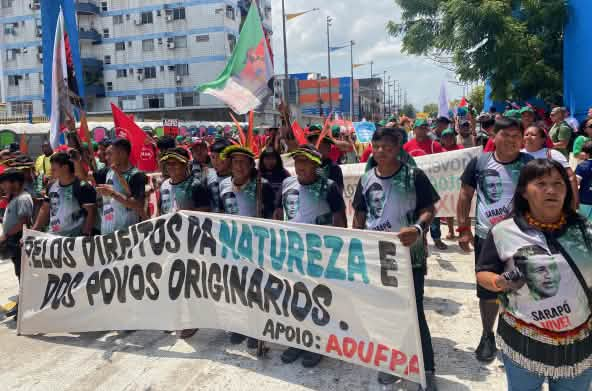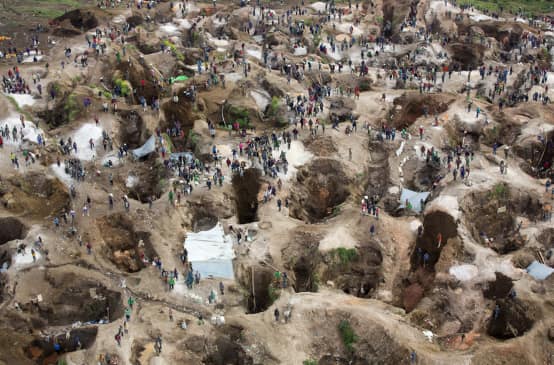
Completed campaign
Brazil wants to fell millions of trees for aluminum – we say NO!
The indigenous Mundurukú people won the fight for their land and forest: the Brazilian environmental authority IBAMA denied the permit for the construction of the São Luiz mega-dam.
Millions of trees are due to be axed in Amazônia to make way for dams to generate electricity for mines and aluminum smelters. But the indigenous Mundurukú people aren’t taking the destruction of their ancestral land lying down – and neither should we. Please speak out against this misguided project!
To: the President of the Federative Republic of Brazil, Dilma Rousseff, and European business representatives
“Cancel the plans for yet more dams in Amazônia. Wind and solar energy are viable alternatives to hydropower.”The planned São Luiz do Tapajós dam looms over the future of millions of trees and numerous villages. The Brazilian government is pushing ahead ruthlessly to tame Amazônia’s rivers and bolster the economy with cheap electricity – a healthy environment and the rights of indigenous peoples are clearly lower priorities.
The Mundurukú are standing up courageously for their land and their rights. Their activists call themselves “Guerreiros” – warriors – and they leave no doubt that they’re not going down without a fight. They will never give up their ancestral home among the Tapajós, Jamanxim and Teles Pires rivers.
The Brazilian government is currently escalating the situation at the Tapajós river. The Mundurukú have not been given a fair hearing since the start of the development project, which involves numerous dams, even though their free, prior and informed consent is required by the constitution and international conventions. The government is currently stalling with the demarcation of their territory, apparently due to pressure by the hydropower lobby. Since September, the indigenous people have taken matters in their own hands and are staking out their own land. The authorities are aware of this, yet they are still granting logging concessions for the land areas due to be submerged.
Meanwhile, the Mundurukú are being harassed systematically by low-flying helicopters buzzing their settlements. Indigenous protesters were pelted with stones and fireworks by hundreds of residents of the town of Jacareacanga with the tacit approval of the police and local politicians.
Call on Brazilian President Dilma Rousseff to cancel the dam projects in Amazônia – the Mundurukú deserve to live in peace in an intact environment.
The forests along the Tapajós are among the world’s most biodiverse. 400 fish and 390 bird species have been documented in Amazônia National Park; rare animals such as jaguars and anteaters can also be found here. “It would be the death of the river as it exists today if it were dammed,” notes Maria Lucia Carvalho, head of Parque Nacional da Amazônia.
Brazil's economy is thirsty for energy, with electricity consumption projected to increase by 4.5 percent a year. To meet those needs, the country is investing in hydropower on a grand scale, which accounted for around 80 percent of its electricity generation in 2011. Despite its vast potential, the contribution of wind and solar energy is currently less than two percent. Nevertheless, the Brazilian government clearly prefers building dams to setting up wind farms.
The São Luiz do Tapajós dam will swallow forests and villages
Nearly 60 major hydropower plants are slated for Amazônia alone. None of the major rivers will be spared and thousands of kilometers of power lines will cut through the forests.
The two most important projects are Belo Monte, which is already being built despite continued protests, and the Tapajós dam complex, which is slated to generate more than 14,000 megawatts (MW). To put that into perspective, a typical coal-fired power plant in the U.S. has an output of 500 MW.
Protected areas are delisted by decree
The Tapajós mainstream is set to be dammed in three places. This would submerge 198,400 hectares of land – an area larger than London – including protected rainforest areas. The Brazilian government found a simple way of dealing with the destruction of 11,000 hectares of the Amazônia and Juruena National Parks and 23,000 hectares of the Itaituba I and II National Forests: it delisted the areas by decree in 2012.
Four dams are planned for the Jamanxim, a tributary of the Tapajós. Their reservoirs would flood a further 103,700 hectares of land – 33,216 of them in Jamanxim National Park and 25,849 in the Jamanxim, Altamira and Itaituba I and II National Forests.
With a capacity of 8,040 MW, the São Luiz do Tapajós some 50 km upstream of the city Itaituba will be the largest of the power plants. The project has progressed the furthest and is meeting with the stiffest resistance. Once completed – according to current plans, in 2020 – it will submerge an area of 730 square kilometers. As if that were not enough, the project will extend to further tributaries of the Tapajós – three dams on the Teles Pires and eight on the Juruena.
Indigenous people take biologists hostage
The indigenous people of the Mundurukú are bearing the brunt of the Brazilian energy sector’s expansion plans. 11,600 of them live in about 120 settlements, and they have made it clear that they are prepared to defend their home. When biologists were sent in quietly to prepare studies for the construction of the dam in São Luiz, the Mundurukú drove them off their land. They captured three researchers and only released them when the government promised to abort the studies. Shortly after they were let go, the biologists returned, this time accompanied by special forces and low-flying helicopters to intimidate the Mundurukú. Theologian and journalist Edliberto Sena describes the government’s treatment of the people as “war tactics”. The Teles Pires rapids – the place where the world originated in the mythology of the Mundurukú – have already been dynamited for the dam. The culture and history of the people is inextricably linked to the site: “It’s like blowing up Jerusalem or the Vatican,” explained Bruna Rocha, an archaeologist.
A dubious idea: flying the workers in by helicopter
The government’s announcement that the projects would be realized as “platform dams” was met with incredulity: workers and materials would be flown in by helicopter, as is done for oil rigs, thus dispensing with access roads, avoiding social conflict with unsolicited jobseekers and protecting the environment. The feasibility of using helicopters to airlift 12,000 workers, heavy machinery and enough steel and concrete to build a dam is another question, of course.
European contractors waiting in the wings?
Brazil’s construction industry has a reputation for being extremely close to the government – a U.S. study suggests a connection between political donations and government contracts. It would be ingenuous to believe the assertions of Brazilian companies and politicians that the bidding processes and construction work is proceeding strictly by the book. European companies also have to face uncomfortable questions regarding their involvement in human rights violations and rainforest destruction in Brazil. Siemens, Voith, Daimler, Allianz and Munic Re are among the companies involved in the controversial Belo Monte dam, for example. It is safe to assume that they intend to continue profiting from the construction boom in Amazônia while their management turn a blind eye toward the social and environmental fallout.
Brazil has alternatives to building new hydropower dams: Electricity generation could be boosted significantly by upgrading existing power plants by replacing their turbines and dredging silted reservoirs. Many overland power lines are past their prime, resulting in transmission losses of 20 percent. The potential of wind and solar energy has been virtually ignored.
To: the President of the Federative Republic of Brazil, Dilma Rousseff, and European business representatives
Madame President,
Ladies and Gentlemen,
The indigenous Mundurukú people are currently resisting the construction of dams on the Tapajós. They fear that their ancestral home is being sacrificed and livelihoods destroyed for the economic growth of Brazil.
The rights of the Mundurukú have been violated for years: their territory has not been demarcated, and officials have gone as far as to claim that the region is uninhabited. The Mundurukú were never consulted about the Complexo Tapajós project despite Brazilian legislation and international agreements such as ILO Convention 169 that require their free, prior and informed consent.
The way in which the hydropower projects on the Tapajós are taking shape strongly resembles that of the Belo Monte dam, which was pushed through in the face of widespread criticism and warnings. The human rights violations and environmental destruction of that project must not be repeated on the Tapajós.
In view of these facts, I call on the representatives of European businesses not to take part in bidding for the hydropower projects.
Madame President, please cancel the plans for yet more dams in Amazônia. Wind and solar energy are viable alternatives to hydropower.
Sincerely,

